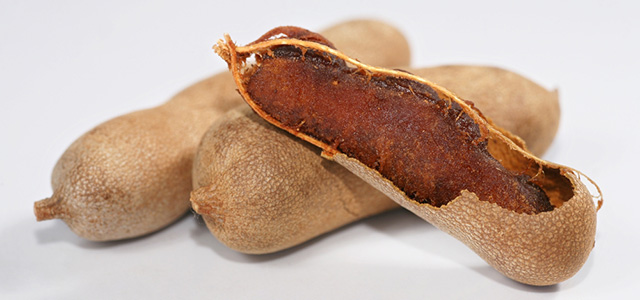Tamarind is a pod-like legume which is indigenous to the tropical regions of Africa, but which is also grown throughout South Asia and Mexico. Inside the hard outer shell of a fully ripened tamarind pod is a fleshy, juicy pulp which is reddish-brown, and which has a mostly sour and citric taste, with a hint of sweetness. In South American countries, tamarind is better known as tamarindo, and is widely used in sauces, beverages such as agua de tamarindo and raspados, frozen fruit bars, as dried and salted savory snacks, and as soft and sweetened candies. Healthy eaters will also be interested in the fact that the flesh of the tamarind pod is high in B vitamins and calcium.
Making your own tamarind concentrate from scratch is rewarding, as prepared tamarind concentrates are sometimes overly thin and watered down, lacking the “punch” of a full-flavored, homemade mash. Your first step is to break open the dried pods and scoop the flesh out with your bare fingers or a small spoon. Place this fruit flesh into a large, clean bowl.
Your next step is to give the tamarind fruit a good soaking, to soften it up for mashing. For every 3 ounces of tamarind fruit, add one cup of warm water. Let the fruit soak for at least 20 minutes before mashing.
After soaking and softening the fruit, the third step is to pour the tamarind water and fruit into a fine sieve held over another large, clean bowl. Press the tamarind fruit through the sieve and into the water you used for soaking. This will separate the stringy membranes and seeds from the fruit.
Lastly, you’ll need to stir the bits of pressed fruit that went through the sieve with the soaking water to create a highly concentrated tamarind liquid. This tamarind concentrate should be stored in a tightly sealed jar and refrigerated. If properly refrigerated, the concentrate will have a shelf life of about one week. You’ll need to shake or re-stir the concentrate before using, as the pulp will have a tendency to settle.
Additional note: If you’re using a block of semi-soft tamarind pulp rather than a whole pod to make tamarind concentrate, the process is largely the same. The pulp will still need to soak in warm water to soften, and will need to be pressed through a sieve to keep the seeds and membranes out. The notable difference is one of convenience: blocks of tamarind pulp prevent having to engage in the first step of breaking open the pods and removing the flesh yourself.


![Making Mealtime Matter with La Familia: Easy Sofrito [Video]](https://thelatinkitchen.com/wp-content/uploads/2015/10/sofrito-shutterstock__0-500x383.jpg)
![Easy Latin Smoothies: Goji Berry Smoothie [Video]](https://thelatinkitchen.com/wp-content/uploads/2015/12/goji_berry-shutterstock_-500x383.jpg)
















![Fun and Fast Recipes: Fiesta Cabbage Salad [Video]](https://thelatinkitchen.com/wp-content/uploads/2015/11/fiesta_cabbage_slaw-shutterstock_-500x383.jpg)









